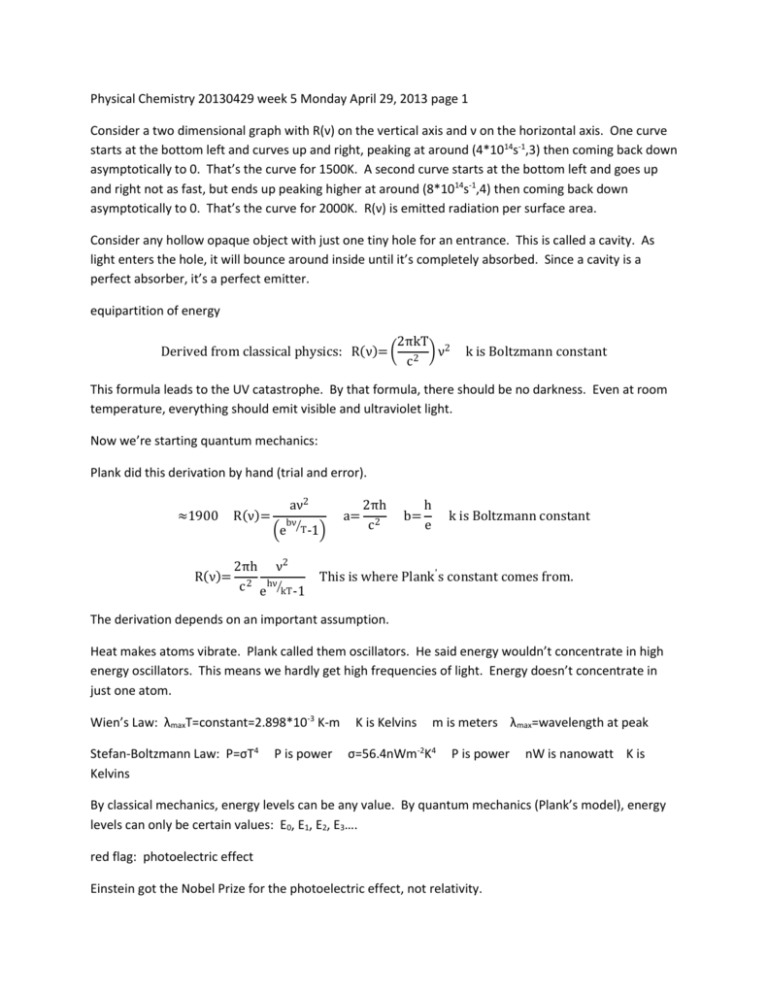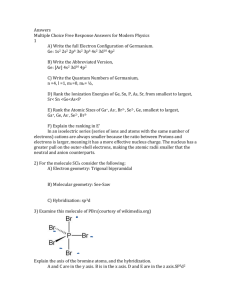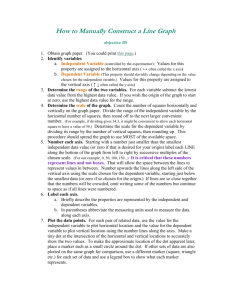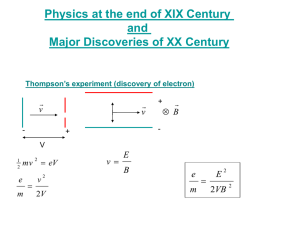Physical Chemistry 20130429 week 5 Monday April 29 2013
advertisement

Physical Chemistry 20130429 week 5 Monday April 29, 2013 page 1 Consider a two dimensional graph with R(ν) on the vertical axis and ν on the horizontal axis. One curve starts at the bottom left and curves up and right, peaking at around (4*1014s-1,3) then coming back down asymptotically to 0. That’s the curve for 1500K. A second curve starts at the bottom left and goes up and right not as fast, but ends up peaking higher at around (8*1014s-1,4) then coming back down asymptotically to 0. That’s the curve for 2000K. R(ν) is emitted radiation per surface area. Consider any hollow opaque object with just one tiny hole for an entrance. This is called a cavity. As light enters the hole, it will bounce around inside until it’s completely absorbed. Since a cavity is a perfect absorber, it’s a perfect emitter. equipartition of energy 2πkT Derived from classical physics: R(ν)= ( 2 ) ν2 c k is Boltzmann constant This formula leads to the UV catastrophe. By that formula, there should be no darkness. Even at room temperature, everything should emit visible and ultraviolet light. Now we’re starting quantum mechanics: Plank did this derivation by hand (trial and error). ≈1900 R(ν)= R(ν)= aν2 bν (e ⁄T -1) 2πh ν2 c 2 ehν⁄kT -1 a= 2πh c2 b= h e k is Boltzmann constant This is where Plank ' s constant comes from. The derivation depends on an important assumption. Heat makes atoms vibrate. Plank called them oscillators. He said energy wouldn’t concentrate in high energy oscillators. This means we hardly get high frequencies of light. Energy doesn’t concentrate in just one atom. Wien’s Law: λmaxT=constant=2.898*10-3 K-m Stefan-Boltzmann Law: P=σT4 Kelvins P is power K is Kelvins m is meters λmax=wavelength at peak σ=56.4nWm-2K4 P is power nW is nanowatt K is By classical mechanics, energy levels can be any value. By quantum mechanics (Plank’s model), energy levels can only be certain values: E0, E1, E2, E3…. red flag: photoelectric effect Einstein got the Nobel Prize for the photoelectric effect, not relativity. Lenard (1900) Consider a metal with a layer of potassium on it. Say electromagnetic radiation hits this from an angle. The EM radiation is symbolized hν. Where the EM radiation hits the surface, electrons come off at the opposite angle. The electrons are symbolized e. Energy comes in packages. ∆E=nhν n=0,1,2,3… ν is frequency h=6.63*10-34 Js Consider a graph with KE (kinetic energy) on the vertical axis and ν (frequency)of the incoming light on the horizontal axis. From a nonzero horizontal position on the x axis (ν0) a diagonal line goes up and right. The x intercept ν0 is the threshold frequency. Consider a graph with number of electrons ejected on the vertical axis and light intensity on the horizontal axis. Assuming ν is constant and ν > ν0, the graph is a straight diagonal line up and right from the origin. Consider a graph of KE (kinetic energy) of the ejected electrons on the vertical axis and light intensity on the horizontal axis. The result is a horizontal line above y=0. This violates classical physics. By classical physics: Iαε2 where ε is amplitude. Einstein (1905): Electromagnetic radiation (light) comes in elementary units (quanta) and it is the energy of the elementary unit (NOT the total energy) that determines whether an electron is liberated or not. G. N. Lewis called these units “photons.” analogy: 2000 machine gun bullets to a target = no damage but 1 15” shell = destroyed target Consider a graph of voltage (V) on the vertical axis and ν (frequency) on the horizontal axis. From a point (ν0,0) a diagonal line goes up and right. The formula for this line is hν=hν0+KE where KE is kinetic energy. The slope of this line is h/e where e is the charge of an electron. KE=.5mv2=eV v is speed V is voltage Charge * voltage = energy hν – hν0 = eV h (ν-ν0 )=V e V is voltage We know e so we can find h. 1 hνphoton =ϕ+ mv 2 2 ɸ is work function. It’s the minimum energy to remove an electron. 1. If hνphoton < ɸ then there is no photoelectric effect. The light gets scattered. 2. Since ν0 = constant for a given metal: ɸ=hν0 ɸ is constant 3. If hνphoton > ɸ then as ν↑ so does the KE of the ejected electron. red flags: 1. heat capacity 2. blackbody radiation 3. photoelectric effect Light is very complex. Light has wave properties: 1. diffraction 2. interference Electrons can undergo diffraction, so electrons can behave like waves. Suppose there is a wall with a small hole. Light hits the wall from the left side, so light can go through the hole. Right of the whole the light spreads out into cocentric circles, centered on the whole. To the right is a screen. See the handout. On the screen there are cocentric circles, with a bright dot at their center. Each larger circle is not as bright as the one inside it.








